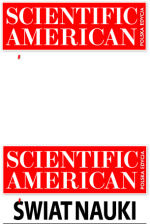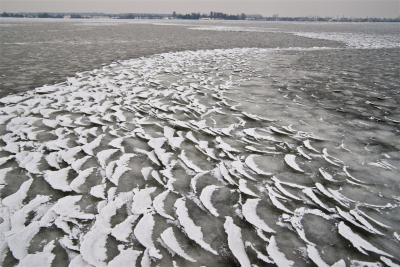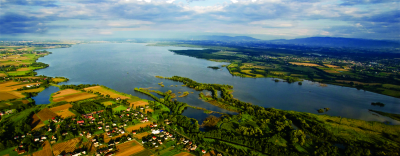 2006
2006
 2008
2008
 2010
2010
 2012
2012
 2014
2014



 |
Four seasons of Goczałkowicki Reservoir
‘Integrated Support System for Management and Protection of Dam Reservoir’
Marek Grucka1 – author of photographs, Pancake ice
|

|
Description popularizing the research project
Digital fish swim in the digital depths of a lake. On the digital bottom sediments lie digital bivalves and Enchytraeidae. Fishes, molluscs and many other animal groups, described with mathematical symbols, feed on plankton expressed with rows of digits. When the sun shines over the digital lake its colours change immediately – the programmed pallet of colours painting its surface reflect the values of temperatures or, if it is necessary, deeper layers of water. What will happen if the warming lasts long? It can be easily checked. It is enough to type in a few more digits to obtain the image of oxygen saturation in the water, contents of chlorophyll, or presence of bacteria in the mud. Sometimes level of water in the digital lake increases. In reality, it would be an ecological disaster. In the computer-generated reality, there is a chance to prevent it.
It is not a review of the newest ‘Lakecraft’ game, although the digital model of Goczałkowicki Reservoir and a computer strategy game have quite a lot of in common. Like in a game decision must be taken quickly e.g. before an oncoming flood wave from the mountains, like in a game the situation may change rapidly when heavy rains come after a long heat wave and stir the water to the very bottom of the reservoir. Yet there are neither winners nor losers. There is only one beneficiary, the Goczałkowicki Reservoir, which provides Silesia with drinking water and takes the brunt of flood waves.
The abundant, although artificially created ecosystem, unlike many other games, cannot be saved and then loaded again. The digital model considers all the phenomena, known to researchers of various branches of science, occurring in the water and sediments, and life processes of the creatures inhabiting it. Its aim is to ensure biological and hydrological equilibrium of the reservoir. Teams of ecologists, toxicologists, hydrologists, zoologists and many other specialists have been completing the necessary data that will help interpret the present and the future of the Reservoir.
For the last few decades, Goczałkowicki Reservoir has been teeming with life in accordance with the eternal cycle of days, nights and seasons. This very life will be reflected in its digital image to make sure that we will not run out of water.
Abstract
The project is coordinated by the University of Silesia, Faculty of Biology and Environmental Protection. The project consortium consists of University of Silesia in Katowice, Cracow University of Technology, Institute for Ecology of Industrial Areas in Katowice, Institute of Environmental Engineering of the Polish Academy of Sciences, Zabrze. The project is co-financed from the European Regional Development Fund under the Operational Programme Innovative Economy. According to the Water Framework Directive in EU countries actions aimed at sustainable management of water resources should be intensified in order to improve their quality by 2015. This also refers to retention reservoirs which are under heavy anthropopression.
European management standards applied for such water bodies require preservation of good ecological potential of water resources and the related ecosystems, use of water from the reservoirs in compliance with their economic function as well as providing safety of the damming up structure in case of natural or technological disasters. The main goal of ZiZOZap is to solve the problem of decreasing ecological and functional potential of dam reservoirs due to their wear and tear and pressure resulting from spatial development of the catchment. The research area of the ZiZOZap project is the Goczałkowicki Reservoir where monitoring and analyses of various environmental elements are carried out by interdisciplinary groups of experts. Data on hydrological, hydrogeological and physico-chemical conditions of water and bottom sediments as well as parameterised ecological and hygienic indicators referring to fauna, flora and the natural environment around the reservoir are collected in integrated databases. Project partners try to identify the key issues related to optimal management of the dam reservoir and build an information system together with a database. Based on the obtained research results and water management scenarios a numeric model of the retention reservoir will be developed. This will allow continuous assessment of the quality and functional state of the reservoir as well as stimulation and forecast of its changes. It is expected that in practice the system of reservoir models will enable to predict qualitative and quantitative changes in water resources which will affect water treatment and minimize costs, as well as forecast water fertility and changes in the reservoir or the surrounding ecosystems. IETU’s role in the project is building a database system as well as development and verification of a multi-layer reservoir model. Our Institute is also responsible for promotion of the entire project. The undertaken research activity will help avoid losses in the environment and high penalties for non-fulfillment of EU obligations by institutions administering the reservoirs. It is expected that the developed universal system will facilitate effective planning and management of the retention reservoirs as well as making reasonable decisions to protect their ecological potential without any infringement of their functions. Measurable results of the project are: improvement of the reservoir potential as a source of drinking water for Silesia, better protection against floods and draughts, maintaining a regular minimal water discharge from the reservoir under draught conditions, protection of natural values and fishery management in the reservoir. Another issue addressed in the project was the potential use of the Goczałkowicki Reservoir for recreational purposes. Project is co-financed by the European Regional Development Fund under the Innovative Economy Operational Programme.
Patronat honorowy
Leszek Jodliński
Dyrektor Muzeum Śląskiego w Katowicach
Zygmunt Łukaszczyk
Wojewoda Śląski
Jan Malicki
Biblioteka Śląska
Piotr Uszok
Prezydent Katowic
Adam Matusiewicz
Marszałek Województwa Śląskiego







 Bird’s eye view
Bird’s eye view







